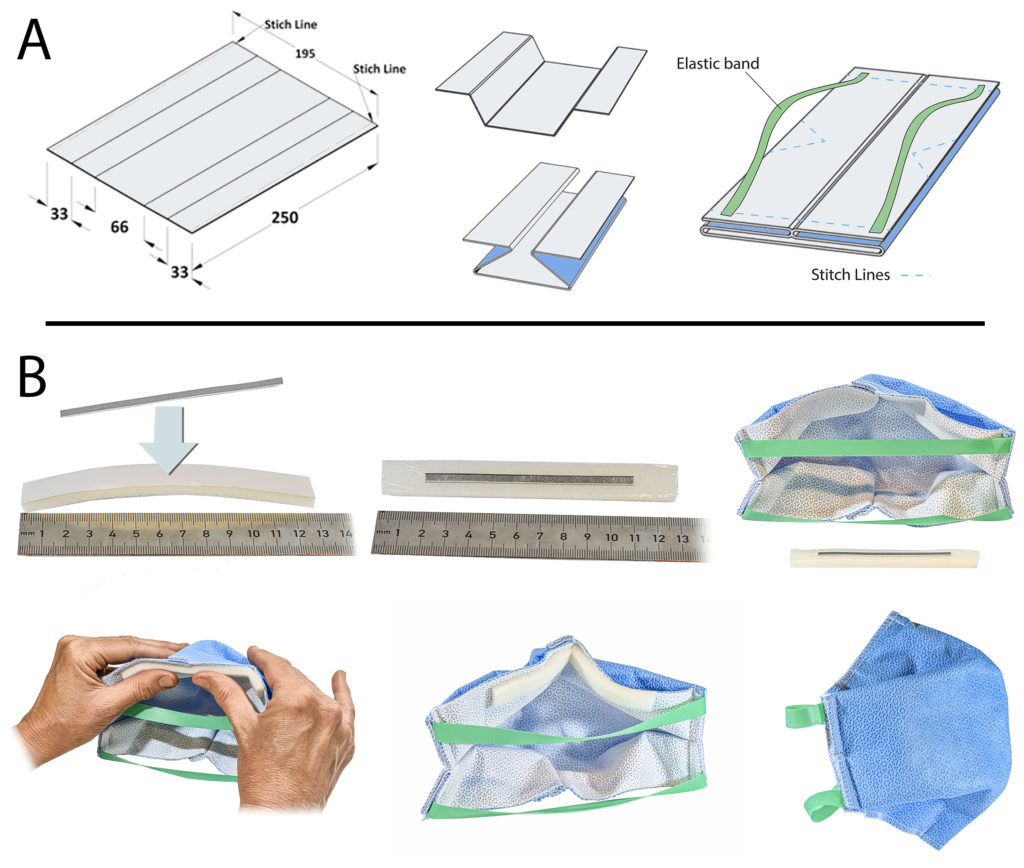Dr. Timo J.C. Oude Vrielink, Prof. Johanna H. Meijer
Department of Medical Technology, Department of Cell and Chemical Biology
Leiden University Medical Center, Leiden, The Netherlands
This is a shortened version of the scientific publication in PLOS ONE:
https://journals.plos.org/plosone/article?id=10.1371/journal.pone.0236239
Given the current shortage of respirator masks and the resulting lack of personal protective equipment for use by clinical staff, we examined bottom-up solutions that would allow hospitals to fabricate respirator masks that: (i) meet requirements in terms of filtering capacities, (ii) are easy to produce rapidly and locally, and (iii) can be constructed using materials commonly available in hospitals worldwide. Because SARS-CoV-2 can be transmitted via respiratory droplets, and potentially including aerosols, the demand for high-quality, well tested respirator masks has increased dramatically. The World Health Organisation (WHO) guidelines require that healthcare workers at intensive cares wear a mask that provides at least FFP2 protection or N95, with FFP2 corresponding to a filter efficiency of at least 94%. In other conditions the WHO recommends healthcare workers to wear surgical masks, which have a higher splash resistance but a lower particle filter efficiency.
We investigated whether sterilization wrapping material is suitability for use in the production of FFP2, N95 or surgical masks. The wrapping material Halyard Quickcheck H300 (manufactured by Owens & Minor) is routinely used in hospitals worldwide to wrap surgical instruments for sterilization.
We found that the wrapping material met the required filtering criteria (Table 1). Specifically, three layers of material achieved a filter efficiency of 94%, 99%, and 100% for 0.3 µm, 0.5 µm, and 3.0 µm particles, respectively. These values are close to the efficiency provided by FFP2 and N95 masks. Two layers resulted in 86.60±1.91%, 98.02±0.46%, and 99.97±0.01%, respectively (satisfying the criteria for an FFP1 respirator mask). Using only one layer of the material satisfies the criteria for use as a ‘surgical mask’. After repeated sterilization, the properties of the material remained sufficient for use as surgical mask.
Table 1. The filter efficiency of the Quickcheck H300 material compared to commercially available masks
| 0.3 µm | 0.5 µm | 3.0 µm | |
| Commercial Surgical Mask | 54.52±2.77% | 88.61±1.13% | 98.92±0.64% |
| Single layer H300 | 70.08±0.48% | 89.68±0.70% | 99.74±0.13% |
| Commercial FFP2 Face Mask | 94.08±0.42% | 99.57±0.04% | 100.00±0.00% |
| Triple layer H300 | 93.84±0.37% | 99.45±0.08% | 99.99±0.01% |
We constructed a complete respiratory mask in order to facilitate production locally in hospitals. We identified a basic set of conventional materials (aluminum, neoprene rubber, and elastic material) with suitable specifications (see Figure 1), recognizing that many other designs will also work. Most hospitals—even in rural areas—have a basic workshop. The only key requirement for our design is a machine to cut aluminum and elastic strips out of larger sheets. The model that we propose is relatively easy to make, and we intentionally designed the mask in such a way that the wearer can breathe through the entire surface of the mask, increasing breathability and thereby comfort.
Our study was specifically aimed to allow for solutions in hospitals and other critical environments. The Halyard wrapping material fulfills the requirements recommended by the WHO and can thus be used to help protect hospital staff and other healthcare professionals who lack commercially available solutions.

Figure 1. A possible design for fabricating a respirator mask with the sterile isolation material. (A) The folding and stitching of the material. (B) The attachment of a nose-clip and the final design. A full description is given in the open access academic publication.